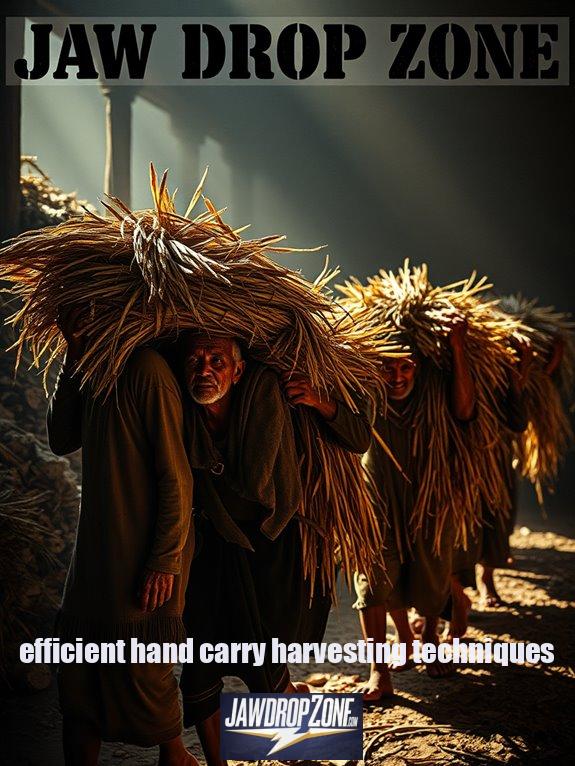Steering childbirth in pre-modern times? Envision facing a one-in-three chance of dying! With bigger brains and bipedalism, motherhood turned into a nail-biting adventure. Midwives wielding ancient wisdom tried to manage complications while surrounded by herbal remedies and superstitions. Quarantine rituals added a dash of drama, and communal chanting seemed to be the pep rally of childbirth. Crazy, right? If you think this is wild, just wait 'til you uncover more about these incredible stories!
Quick Takeaways
- Midwives, as primary caregivers, utilized generational wisdom to navigate the complexities and risks of childbirth in pre-modern life.
- Cultural practices varied, with family support and rituals helping mothers cope with labor challenges.
- Positioning during labor, such as squatting or kneeling, was influenced by cultural norms and aimed at easing childbirth.
- Maternal mortality rates were significantly high, with historical estimates showing one in three women faced life-threatening risks during delivery.
- Herbal remedies and superstitions were commonly employed to provide comfort and perceived safety during labor, reflecting community beliefs.
Challenges and Triumphs of Pre-Modern Childbirth

Childbirth, as it turns out, isn't just a simple event; it's a wild ride through evolutionary obstacles and cultural practices that would make even the toughest adventurer hesitate. Imagine this: our human ancestors had to deal with bigger brains and bipedalism while giving birth. Talk about a head-to-pelvis ratio nightmare! No wonder childbirth's a bit of a circus act—obstructed labor and cephalopelvic disproportion are just a few of the thrilling attractions in this dangerous show.
Now, let's not forget our trusty sidekicks: midwives. These women were the original rock stars of childbirth, armed with wisdom passed down through generations. They weren't just there to hold a hand; they managed complications like pros, using techniques that sometimes felt like ancient magic. But when male physicians entered the scene, it was like a band breaking up—suddenly, midwives found themselves sidelined.
And what about the communal vibe of childbirth? In many cultures, family and friends gathered to support the laboring mother, which sounds fabulous until you realize it could also turn into a spectator sport. The rituals and positions varied wildly—standing, squatting, kneeling—like a bizarre yoga class gone rogue. Interestingly, various cultures have unique childbirth rituals that often involve spiritual elements and quarantine practices for mothers before and after childbirth.
But here's the kicker: maternal mortality rates were sky-high, especially in the medieval era. One in three women? Yikes! Thankfully, advances like antiseptics and modern medical tools have dramatically reduced those numbers.
Herbal Remedies and Superstitions

Amidst the chaos of childbirth, a fascinating world of herbal remedies and superstitions emerges, one that's as rich as it's bewildering.
Ever tried pulverized fox vine in your beer? I haven't, but ancient Mesopotamians swore by it!
Or how about a community chanting incantations while you're in labor? Talk about a dramatic birth announcement!
Who knew childbirth could be this entertaining?
References
- https://www.birthinjuryhelpcenter.org/birth-injuries/delivery-complications/childbirth-history/
- https://www.elcaminohealth.org/newsroom/navigating-challenges-childbirth-certified-nurse-midwife
- https://www.campop.geog.cam.ac.uk/blog/2024/09/19/childbirth-in-the-past/
- https://pce-fet.com/common/library/books/51/2590_[Paul_D._Leedy
- https://www.cdc.gov/mmwr/preview/mmwrhtml/mm4838a2.htm
- http://scielo.isciii.es/scielo.php?script=sci_arttext&pid=S0211-95362014000200002
- https://masterblogging.com/blog-post-research/
- https://avivaromm.com/labor-induction-low-natural-approaches-midwife-md/
- https://www.pcsb.org/cms/lib/FL01903687/Centricity/Domain/109/Practical Research 11th Edition.pdf
- https://www.midwiferytoday.com/mt-articles/herbal-education-midwives/












